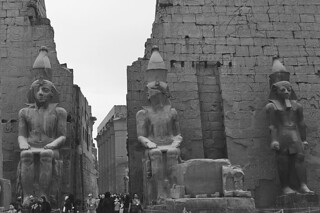 The trip to Luxor was a trip of a lifetime. I enjoyed my Egyptian history from highschool and the trip allowed me to see that history in glorious colors.
The trip to Luxor was a trip of a lifetime. I enjoyed my Egyptian history from highschool and the trip allowed me to see that history in glorious colors. This Pinoy was in travel heaven again!
Our wake up call was at 3am for our 6:30am flight from Cairo to Luxor via EgyptAir. We've only had arrived in Egypt from the U.S. a few hours earlier. By this time, we have not had seen any ancient Egyptian antiquities so our excitement trumped our lack of sleep.

Luxor is the modern day name of the ancient Egyptian city of Thebes. Thebes, at one point, was the ancient Egyptian's capital city and was an important city for spiritual places and festivals. Thebes included important temples such as Karnak and Luxor on the East Bank of Nile and funerary places for Kings and Queens on the West Bank of Nile. The Arabs called it Al-Uqsur which is where modern day Luxor came from.
From the Luxor airport, we were picked up by our tour bus whisked us away to our first destination which was the Temples of Karnak. The picture below is a miniature version of the entire complex or the Amun Temple enclosure. At this point, I could see the complex is big but I had no idea that the tour was going to be an experience so huge that it took me a few days to absorb - all 250 acres of tall obelisks, soaring columns, and imposing statues. Since I am not an expert in Egyptian history, I'll just give you a virtual tour.
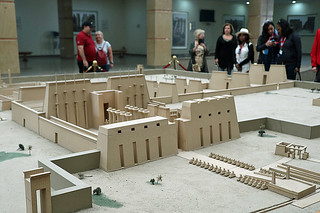
Upon our arrival at the Quay of Amun towards the entrance of the temple complex, I could feel an overwhelming sense of awe and at the same time I was starting to realize how gigantic these antiquities are as we walked along the avenue of the sphinxes. As the first antiquity we visited in this trip, it was very awe inspiring.
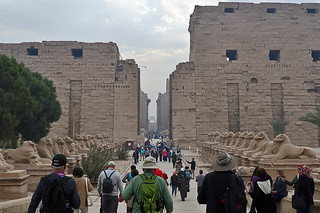
This is a close up of the walls in the complex. Notice how there are very little or almost no space at all in between the stones. The walls have weathered through the centuries of being exposed to the elements but I could imagine these walls were smooth and gleamed two thousand years ago.

As we passed through the first pylon, we went inside what are called chapels. There are three chapels for the Egyptian gods - Mut, Amun and Khonsu. We were told that the complex was built over the span of 2000 years beginning in the Middle Kingdom through the New Kingdom where famous pharaohs like Ramses II and Queen Hapshetsut had left their marks in the temple.

Here is the Colossal statue of Ramses II and what looked like a broken column. I heard once that Luxor is like an open air museum. I could see that while walking around the complex.
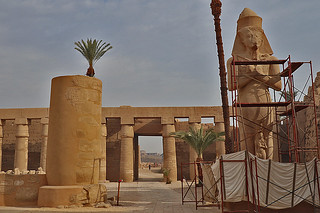
I could see lots of ruins beyond the second pylon. From afar, it looked like there are huge structures and hundreds of them. It was hard to imagine how these giant columns and walls were built using the technology at that time.
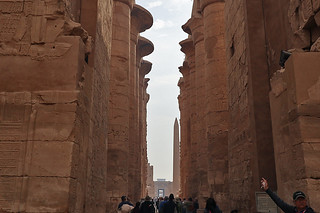
The area beyond the second pylon is called the Great Hypostyle Hall. I had to sit for a moment to take the grandeur of the scenery all in. This hall is huge and containing rows and rows of very tall papyrus-shaped columns. Everything drowned me. Not just the sheer size of the structure, but all the countless details such as the meaning of the hieroglyphs, the different times they were added and under which pharaoh.
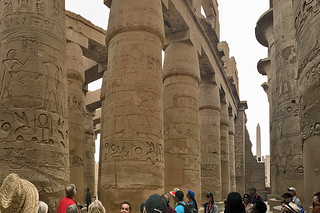
At this point, I was feeling super excited and was taking pictures like there's no tomorrow at the same time feeling overwhelmed with all the information I am hearing. Here are samples of sunken hieroglyphs.

The late morning light also created amazing contrasting colors so I was finally understanding the very early wake up call so that we could be here while there is morning light. I was curious what would the complex look like in the afternoon light.
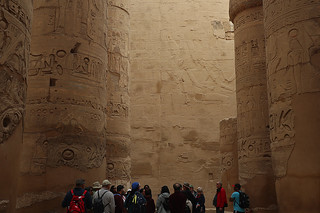
We were allowed to be on our own for a few minutes so I was able to return to the areas I wanted to take more pictures of. Here's an upclose look at the raised relief found in the northern part of the hall built by Seti I.
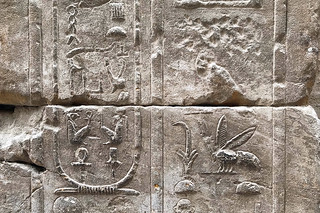
Here's one of the two 30 meter high obelisks erected by Queen Hatshepsut to honor her father Amun. There is another obelisk but it is broken. The top part of the broken obelisk is located near the Sacred Lake, also inside the complex.

This is the Eight pylon.
This complex is really big and I could see its expanse from this vantage point.
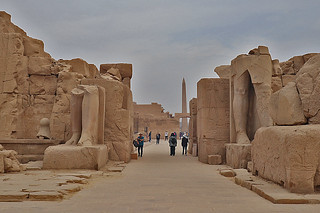
This is the Night pylon. This was the last place I saw during the few minutes that they let us wander around the complex on our own.
My brain was suddenly flooded with lots new experiences and lots of new information. Remember, this was the very first ancient Egyptian ruins that I saw. We were told that there is a very good light show at night but that part was not part of our itinerary.
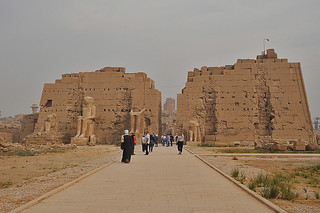
We boarded our tour bus to our next destination - Luxor Temple. My first glimpse of Luxor Temple was from our tour bus looking out to Abou Al Hagag Square. I could see the First Pylon and the mosque built inside the temple. I was still reeling from information overload from the first site of the day so all I remember from this tour of Luxor Temple is that the temple was dedicated to the cult of the Royal Ka - Amun, Mut and Khonsu. Amenhotep III, Queen Hatshepsut, Tutankhamun and Ramses II all contributed to the
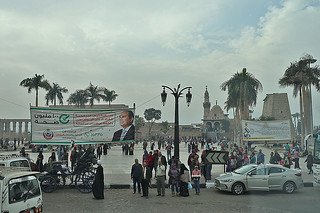
We walked a few yards from where our tour bus dropped us off. Here is the entrance of the Luxor Temple and the view of its First Pylon. We were told that there are supposed to be six statues of Ramses II but only five survived. In addition, there are supposed to be a pair of obelisks but only one is left standing in the complex. We were told that the other obelisk is at the Place de la Concorde in Paris.

Luckily, I was in Paris in 2018 and took this picture of the Place de la Concorde without knowing the history about the obelisk in the middle of the square.
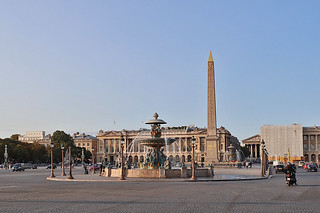
This is called the Triple Barque Shrine. It behind the First Pylon and across from the mosque. It was a shrine that Queen Hapshetsut built but had taken over by Ramses II.
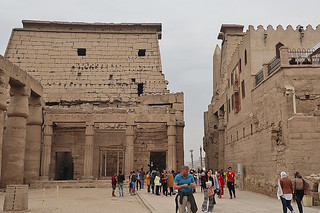
This is the Great Court of Ramses II. It was hard to take photos because we arrived right after noon and the area was already packed with bus loads of tourists. I wonder how over tourism is adding to the degradation of these historical sites?

The Great Court of Ramses II is surrounded by these columns and statues so I had to take the pictures of each of its side in order to capture the entire place. This picture is looking toward Southwest.

This picture is looking towards the Western side.

This a side view of the Great court of Ramses II with a seated statue of himself.
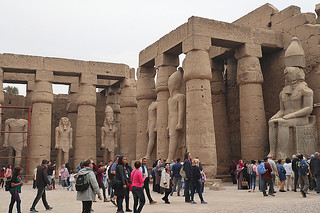
This is the sunken reliefs on the side of the seated statue of Ramses II on our way to the

This is what is written on the lower part of the same side of the seated statue of Ramses II.

This view is towards the Collonade of Amenhotep III. I learned from our tour guide that this is an older part of the temple and was built as the grand entrance to the Temple of Amun.

This still in the Collonade of Amenhotep III but looking up.

This still in the Collonade of Amenhotep III but looking north.
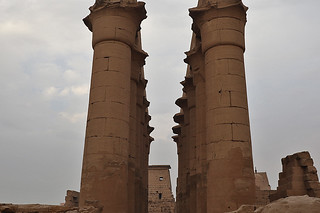
This is the Sun Court of Amenhotep III which is a Hypostyle hall consisting of four rows of eight columns each.
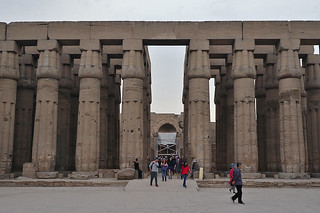
The Sun Court leads to the Chamber of Amun. There are scenes depicted on the walls of this tiny chamber, some of them in faint colors. The chamber is small and lots of people congregating in this area so it was hard to take a photo.
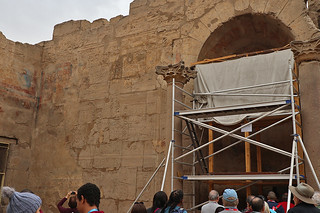
This is a wall inside the Chamber of Amun. These are the first hieroglyphs I had seen in colors. I can't help but imagine how this room looked like during the peak of Egyptian empire's power.

This is a raised relief inside the Chamber of Amun.
I remember from our tour guide that this chamber was built by Alexander the Great and these reliefs depict him as a Pharoah and making an offering to the Egyptian gods.

This is the entrance to the Antechamber. At this point, it was slow moving. I wonder if there is a day or time during the week when this place is empty?
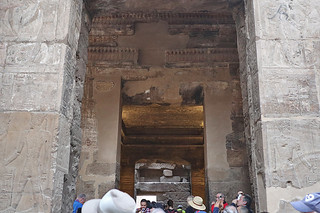
This is a sample relief inside the Antechamber. It would have been great if we could have lingered in this room to see more of the scenes depicted on the walls. Unfortunately, we spent more time waiting to get it. We were also a part of a tour group so we had to move on.
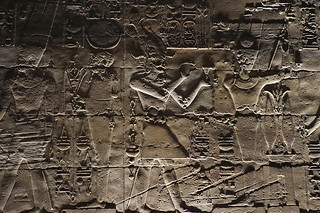
These are the walls inside the Sanctuary of Amenhotep III.

This area contained ruins and artifacts which used to be part of the temple. The ruins are each tagged with a number and description. It looks like archeologists are still going through the ruins like a jigsaw puzzle.
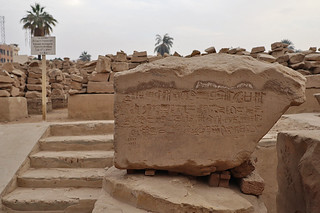
This is the area where the Roman built another structure but now in ruins.

We were told that the Egyptian government is trying to clean and restore the Avenue of the Sphinxes so that it connects to the Temples in Karnak. Just like in the ancient times.

We got back on the tour bus and on to our last destination for that day - a Papyrus demonstration.

So far, we've only toured sites and have not had any contact with locals. Except for our tour guide and bus driver, this was going to be the first time we were meeting a local. As part of their local customs, tea is offered to visitors. They offered us these refreshing hibiscus tea before the demonstration.

Here are the materials needed to make a sheet of paper from papyrus - a papyrus stalk, a hammer, a rolling pin, and a papyrus paper press.
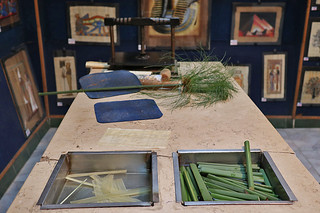
A papyrus plant, which used to grow abundantly along the banks of the Nile River and was considered as sacred by the ancient Egyptian is the source of the fiber in a papyrus paper. The knife is used to peel the green bark so that the white pulp can be exposed. Here's a papyrus reed stalk.

Here's our demo. After removing the green bark, the papyrus paper expert hammered the white pulp and flattened it using a rolling pin to remove the water. The flattened pulp is then put in water for a few days to remove the excess sugar.
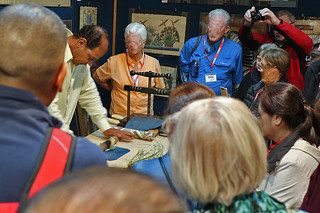
Here's a papyrus reed peel after it has been flattened and washed. The paper is formed by lining the pieces crisscross and placed in between carpet covers and then placed in the press for another few days to the pieces would stick together.
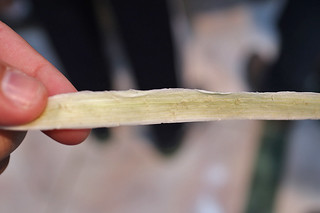
Here's a papyrus paper press.
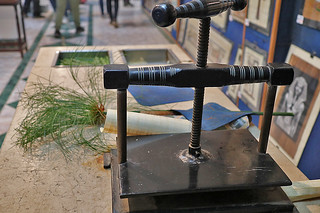
Here's the finished product. Can you see the lines created where the pieces of the flattened reeds are pressed together? The bond is actually pretty strong. The texture is fibrous and thicker than the modern day paper.

That ended our tour of the East Bank of Luxor.
I was very exhausted after our first day of Egyptian site seeing - physically and mentally. Lots of historical information to process and lots of new amazing experiences to take and ponder.
I am so grateful that I was able to see these ruins in person. It gave me a new perspective on how advanced the ancient Egyptian empire was and their engineers, architects and builders were the very best at that time because what they built stood the test of time.
~rl
No comments:
Post a Comment